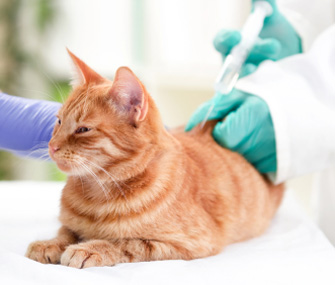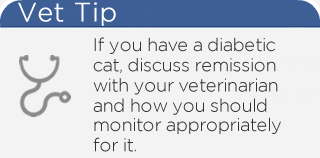Preventing and Handling Diabetic Emergencies
Published on October 30, 2013

Caring for a pet with diabetes can be daunting. Fortunately, the key to successful diabetes management is simple: a consistent, established daily routine.
A healthy diet is essential, and feeding your pet the same amount of food at the same time every day will help make blood sugar easiest to control. Your pet will usually also need twice-daily insulin injections, which should be given at the same time every day. (The easiest way to do this is to coordinate shots with mealtimes.) Routine daily exercise and regular at-home monitoring of urine and/or blood sugar round out a plan for good diabetic regulation.
Even if you are following a consistent routine, a diabetic pet may occasionally experience an emergency. A number of different things can cause an emergency, but the most common is hypoglycemia, or low blood sugar. In this case, it is important that you be prepared in order to avoid a life-threatening situation.
Hypoglycemia: Why It Happens

Hypoglycemia most often results from accidental overdosage of insulin, but it can also occur if a pet is not eating well, misses a meal or vomits after eating, or if the type and amount of food he is being fed changes. Hypoglycemia may become a problem with very vigorous exercise; for this reason, regular daily controlled exercise is best.
Hypoglycemia can also result if the body’s need for insulin changes. This scenario is particularly common in cats who often return to a non-diabetic state once an appropriate diet and insulin therapy start.
Vet Tips
- Avoid “double-dosing” insulin. Only one person in a household should have the responsibility of giving insulin. A daily log should be kept of the time/amount of food and insulin that is given to avoid errors.
- Proper daily monitoring of blood and/or urine glucose can help identify changing insulin needs in order to avoid a hypoglycemic crisis.
Signs of Hypoglycemia
The signs of hypoglycemia may occur suddenly and include:
- Lethargy or dullness
- Restlessness, anxiety or other behavioral changes
- Weakness, difficulty standing or a staggering gait
- Muscle twitching
- Seizures
- Coma
- Death
Hypoglycemia: First Steps at Home
If your pet is showing signs of hypoglycemia and is able to eat, feed him a meal. If he is not alert, hand-feed him corn syrup or honey until he is alert enough to eat his normal food. At that time, feed a meal of his normal food.
If your pet is unconscious, rub a tablespoon of corn syrup or honey on his gums. If he regains consciousness, feed him and get him to your veterinarian for continued observation. If he remains unconscious, this is a medical emergency and you should seek veterinary help immediately!
Vet Tips
- Always have corn syrup or honey in your home and in your first-aid kit/car in order to be prepared for hypoglycemic emergencies.
- You should not give another dosage of insulin after any hypoglycemic episode until you have spoken to your veterinarian.
Hypoglycemia: At the Hospital
Hypoglycemia is a life-threatening emergency. When you get to the vet’s office, your pet’s blood glucose will immediately be checked to determine if intravenous sugar solutions are necessary or if he is stable enough to be managed by withholding insulin and giving food.
If an insulin overdose or missed meal is not to blame for your pet’s hypoglycemia, your veterinarian will need a complete history from you and will perform a full examination to determine how to adjust his insulin in order to prevent a future hypoglycemic crisis.
Most often, dogs and cats will recover from hypoglycemic episodes; however, these episodes can be life-threatening and should be treated as emergencies.
Cats and Hypoglycemia

Cats are unique in that many revert to a non-diabetic state (called diabetic remission) within the first four months of beginning appropriate diet and insulin treatment for diabetes. When remission occurs, a cat becomes non-diabetic and no longer requires insulin therapy. If an owner is not monitoring blood or urine glucose levels routinely, diabetic remission can go unnoticed, and if insulin injections are continued, hypoglycemia may occur.
Other Diabetic Emergencies
Although less critical than hypoglycemia, other symptoms that could indicate an impending emergency include:
- Complete loss of appetite or an appetite that is decreased for several days
- Vomiting or diarrhea
- Straining to urinate or blood in the urine, which could indicate urinary tract infection
- Ketones detected on routine at-home urine testing
It is always best to contact your veterinarian if you are concerned about any changes in your diabetic pet. Make sure to see your veterinarian every three to four months even if your pet’s diabetes is stable, and make sure you have a plan for how to handle any after-hours emergencies.
The Importance of Cat Health Insurance
Your cat health insurance policy can help to offset unexpected treatment costs. These costs may include veterinary visits, prescription medications, or procedures such as imaging or surgery.
Find a personalized plan for your cat by using the insurance finder below:





